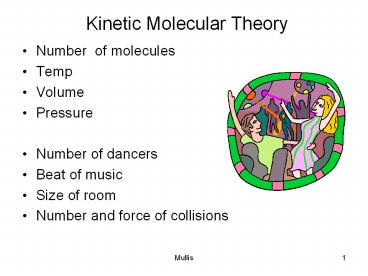Kinetic Molecular Theory PowerPoint PPT Presentation
1 / 14
Title: Kinetic Molecular Theory
1
Kinetic Molecular Theory
- Number of molecules
- Temp
- Volume
- Pressure
- Number of dancers
- Beat of music
- Size of room
- Number and force of collisions
2
Kinetic Molecular Theory
- Accounts for behavior of atoms and molecules
- Based on idea that particles are always moving
- Provides model for an ideal gas
- Ideal Gas Imaginary Fits all assumptions of
the K.M theory - Real gas Does not fit all these assumptions
3
5 assumptions of Kinetic-molecular Theory
- Gases large numbers of tiny particles that are
far apart. - Collisions between gas particles and container
walls are elastic collisions (no net loss in
kinetic energy). - Gas particles are always moving rapidly and
randomly. - There are no forces of repulsion or attraction
between gas particles. - The average kinetic energy of gas particles
depends on temperature.
4
Physical Properties of Gasses
- Gases have no definite shape or volume they
take shape of container. - Gas particles glide rapidly past each other
(fluid). - Gases have low density.
- Gases are easily compressed.
- Gas molecules spread out and mix easily
5
- Diffusion mixing of 2 substances due to random
motion. - Effusion Gas particles pass through a tiny
opening..
6
Real Gases
- Real gases occupy space and exert attractive
forces on each other. - The K-M theory is more likely to hold true for
particles which have little attraction for each
other. - Particles of N2 and H2 are nonpolar diatomic
molecules and closely approximate ideal gas
behavior. - More polar molecules less likely to behave like
an ideal gas. Examples of polar gas molecules
are HCl, ammonia and water.
7
Gas Behavior
- Particles in a gas are very far apart.
- Each gas particle is largely unaffected by its
neighbors. - Gases behave similarly at different pressures and
temperatures according to gas laws.
8
Boyles Law
- Pressure goes up if volume goes down.
- Volume goes down if pressure goes up.
- The more pressure increases, the smaller the
change in volume.
9
Boyles law
- Pressure is the force created by particles
striking the walls of a container. - At constant temperature, molecules strike the
sides of container more often if space is
smaller. - V1P1 V2P2
- Squeeze a balloon If reduce volume enough,
balloon will pop because pressure inside is
higher than the walls of balloon can tolerate.
10
Charles Law
- As temperature goes up, volume goes up.
- Assumes constant pressure.
- V1 V2
- T1 T2
T , V
11
Charles law
- As temperature goes up volume goes up.
- Adding heat energy causes particles to move
faster. - Faster-moving molecules strike walls of container
more often. The container expands if walls are
flexible. - If you cool gas in a container, it will shrink.
- Air-filled, sealed bag placed in freezer will
shrink.
12
Gay-Lussacs Law
- As temperature increases, pressure increases.
- Assumes volume is held constant.
- P1 P2
- T1 T2
- A can of spray paint will explode near a heat
source. - Example is a pressure cooker.
13
Combined Gas Law
- In real life, more than one variable may change.
If have more than one condition changing, use the
combined formula. - In solving problems, use the combined gas law if
you know more than 3 variables. - V1P1 V2P2
- T1 T2
14
Using Gas Laws
- Convert temperatures to Kelvin!
- Ensure volumes and/or pressures are in the same
units on both sides of equation. - STP 0 C and 1 atm.
- Use proper equation to solve for desired value
using given information. - V1P1 V2P2 V1 V2 P1 P2 V1P1
V2P2 - T1 T2 T1 T2
T1 T2

